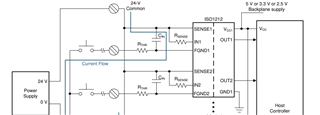Hi Team
Customer is using ISO1212 in their new project and have serverals questions:
- What's the failure mode of ISO1212 in output side? (Output HIZ? or Output open?)
- ISO1212 data rate is up to 4Mbps, for low speed digital input channel, could we add RC filter to limit the bandwidth? Where should I place the RC circuit?
- What's the major purpose of the CIN in below diagram?
- Do we have internal pull-up or down for OUT pin?


